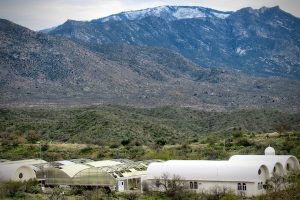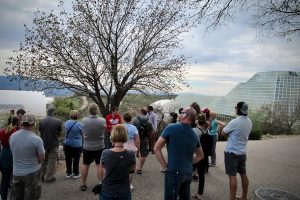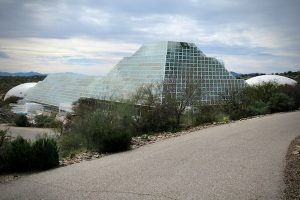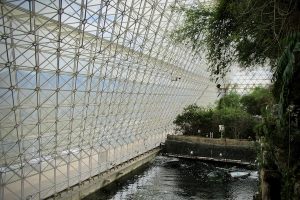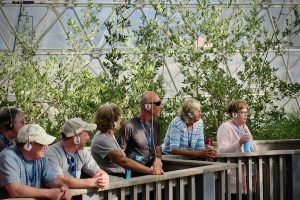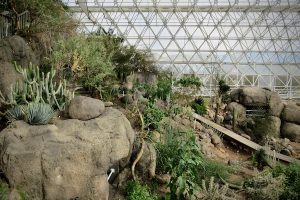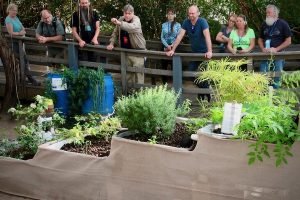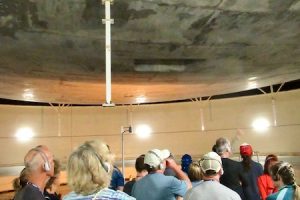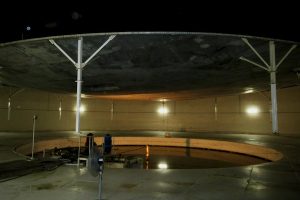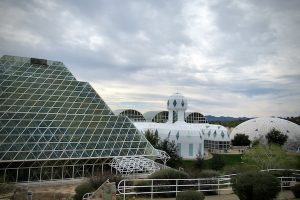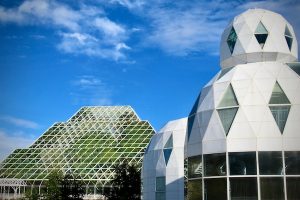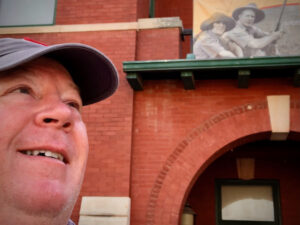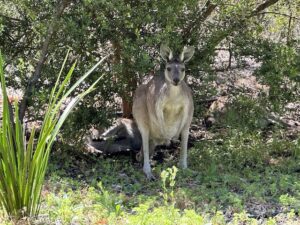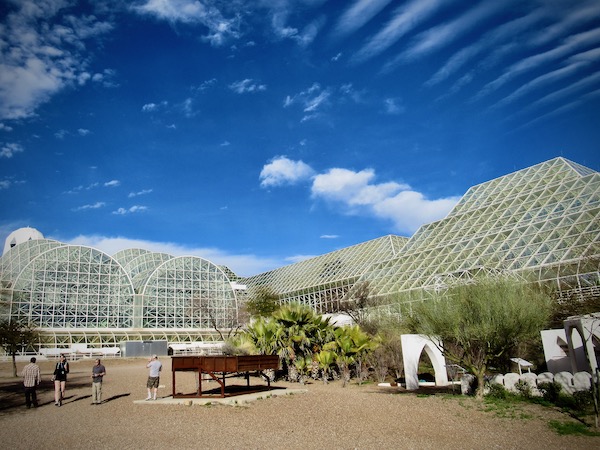
I am here at Biosphere 2 to set the record straight. Yes. Absolutely. Bio-Dome, the 1996 film, is one of the worst movies ever made. Comedian and Beverly Hills High School grad Pauly Shore and an up-and-coming, not-quite-yet-born-again Stephen Baldwin star as a couple of dimwits who get locked inside what they believe to be a shopping mall. Turns out (wait for it) the morons have been sealed inside a closed ecosystem known as a “Bio-Dome” with a bunch of scientists – for an entire year.
Even the infamy of wacky heiress-slash-terrorist Patty Hearst and the boozy half-brother of a U.S. President Roger Clinton could not rescue this mess – although Australian pop star Kylie Minogue does shine as Dr. Petra von Kant.
And, no. The two year (1991-93), US$200 million Biosphere 2 mission of the so-called eight intrepid Biospherians, or “terranauts,” as they were called, did not fail. Earth, aka Biosphere 1 (if you were wondering), may be a total mess, but not Biosphere 2!
Sure, there were some miscalculations, as described in this NY Times story from 1996. Like, when the oxygen levels inside the sealed ecosystem dropped to 14.5 percent (normal is 20.8 to 21 percent) – what you find at 13,300+ feet. After a time, that’s possibly brain damage territory (maybe hard to detect in this motley crew), so mission control ultimately was forced to pump in oxygen for the duration.
Apparently, there also were a gazillion microbes in the soil, which released CO2 faster than the plants could photosynthesize it. Later research showed the plants competing for the CO2 with the exposed concrete inside, which was converting it into calcium carbonate.
Then there were the animals and insects. Some 19 of the 26 types of animals brought inside died – and no, there were no tigers. The insects didn’t do much better, with all the bees and other pollinators dying off, which left most plants seedless. Meanwhile, the cockroaches (as usual) and the crazy ants – you know, the ones that get all riled up when you mess with them – thrived.
Really, any research that did come directly out of the experiment was pretty sketchy, as the crew – made up mostly of hipster Utopians Roy Walford, Jane Poynter, Taber MacCallum, Mark Nelson, Sally Silverstone, Abigail Alling, Mark Van Thillo, and Linda Leigh – spent the vast majority of their time trying not to starve. It probably didn’t help that the struggling terranauts literally could see curious onlookers directly outside the facility windows eating hot dogs and pizza, according to my tour guide.
Walford lost 58 pounds. Poynter, who would later marry MacCallum, started to turn orange, the guide said, because of all the sweet potatoes she ate. And the entire crew was reduced to eating sorghum for breakfast every day. That’s what farmers feed their chickens and pigs.
And that’s not even the worst of it. When the eight terranauts were set to emerge – finally, after two years exactly – the door opening was delayed by 20 minutes while that old windbag Dr. Jane Goodall droned on and on about her illicit affair with Cheeta or Chim Chim or some other ridiculous monkey (as immortalized in the title of Jane Poynter’s book: The Human Experiment: Two Years and Twenty Minutes Inside Biosphere 2.
Yes, utopia had its fair share of problems. But, as this Wired Magazine article from 2009 says, Biosphere 2 was not such a bust. As a result of those two tumultuous years, we now:
- Have a general idea what it would be like to live in outer space or on another planet, like Mars.
- Know how to seal things really, really well. The space shuttle, for example, lost 2 percent of its oxygen per day. Biosphere 2 only lost 10 percent in an entire year.
- Understand the relationship between carbon dioxide and oxygen better, which will help in the research around climate change.
- How to produce enough food to (barely) sustain eight people for two years on less than a half acre – soil is a must –and that hydroponics alone won’t cut it.
- How to treat wastewater using wetlands, one of the seven “biomes” inside Biosphere 2, which also includes a rainforest; an ocean with coral reef; a fog desert; a savannah grassland; an agricultural area; and, living space for the humans.
And Biosphere 2’s story did not end in 1993. Another sealed environment mission took place at the property for nine months in 1994. Then Columbia University came in to manage research there 1995 to 2003. The University of Arizona saved the facility from almost certain strip mall, retirement-living redevelopment in 2007, and then took full ownership in 2011. They continue to use Biosphere 2 for several projects, including something called the Landscape Evolution Observatory, and other research relevant to a possible mission to Mars.
So while Biosphere 2 ambles on, the Bio-Dome movie franchise thankfully has hit a wall – despite persistent rumors a sequel is in the works. Stephen Baldwin and Pauly Shore together again? Once is more than enough.
Entry to Biosphere 2 is $21 for adults, $19 for seniors and the military and $14 for children ages 5 to 12. There’s another $8 charge if you take the tour (highly recommended). Normal operating hours are every day from 9 am to 4 pm, except for Thanksgiving, Christmas and pandemics.

